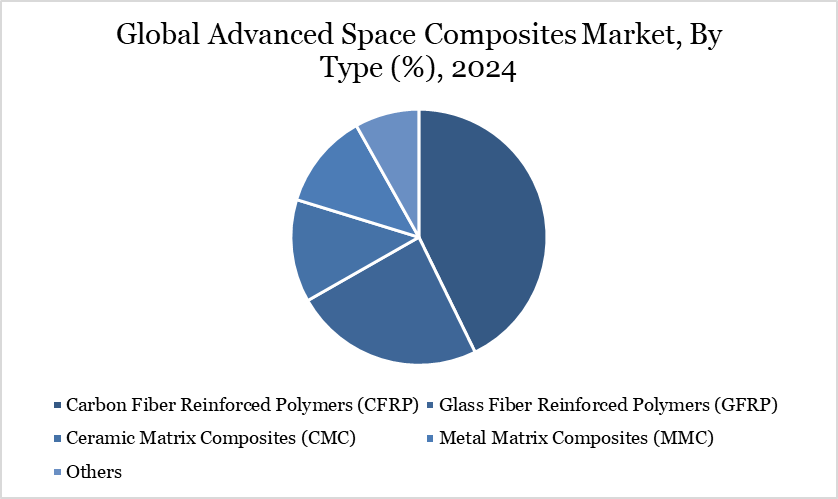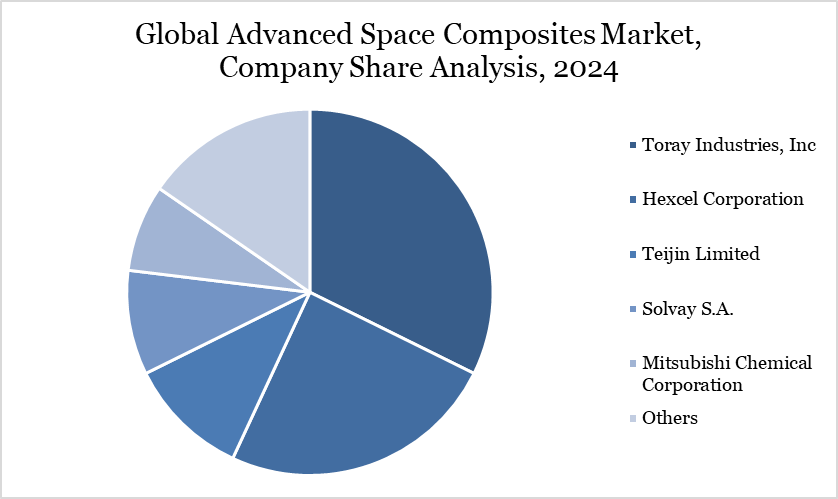Advanced Space Composites Market Overview
Global Advanced Space Composites Market reached US$ 3.48 billion in 2024 and is expected to reach US$ 13.20 billion by 2032, growing with a CAGR of 18.13% during the forecast period 2025-2032.
The Advanced Space Composites Market is experiencing rapid growth as demand intensifies for lightweight, durable, and high-performance materials capable of withstanding the harsh conditions of space. One of the primary advantages of advanced space composites is their exceptional strength-to-weight ratio, which significantly reduces the overall mass of spacecraft allowing more room for payload and fuel.
For instance, SpaceX utilizes carbon fiber composites in its Falcon 9 and Starship vehicles to improve structural efficiency and payload capacity. These materials also provide superior thermal and chemical resistance, essential for surviving extreme temperature fluctuations during re-entry or in orbit, as seen in NASA’s use of CMCs for thermal protection systems. Above advantages position advanced space composites as indispensable in the evolving aerospace landscape.
Advanced Space Composites Market Trend
The advanced space composites Market is shaped by several emerging trends driven by the growing complexity of space missions and the push for lighter, more durable materials. One of the key trends is the increasing use of 3D printing and additive manufacturing to produce composite structures in orbit, reducing the need to launch heavy components from Earth.
Companies like Orbital Composites are actively working on space-qualified robotic 3D printing systems under contracts from organizations like the US Space Force. Another major trend is the integration of smart composites embedded with sensors and self-healing capabilities to enhance structural health monitoring and longevity during long-duration missions.

For more details on this report - Request for Sample
Market Scope
| Metrics | Details |
| By Type | Carbon Fiber Reinforced Polymers (CFRP), Glass Fiber Reinforced Polymers (GFRP), Ceramic Matrix Composites (CMC), Metal Matrix Composites (MMC), Others |
| By Platform | Satellites, Rockets/Launch Vehicles, Space Probes, Space Stations, Others |
| By Application | Satellite Structures, Launch Vehicles, Payload Fairings, Solar Arrays and Panels, Antennas and Reflectors, Others |
| By Region | North America, South America, Europe, Asia-Pacific, Middle East and Africa |
| Report Insights Covered | Competitive Landscape Analysis, Company Profile Analysis, Market Size, Share, Growth |
Advanced Space Composites Market Dynamics
Growing Private and Government Space Programs
The growing involvement of private and government space programs is a major driver propelling the advanced space composites market. As the global space industry shifts from being government-dominated to a more commercialized ecosystem, the demand for advanced materials that enhance performance and reduce costs has intensified. For instance, in 2022, the primary mandate of HSFC is to spearhead ISRO's Gaganyaan programme through co-ordinated efforts and focus all the activities that are carried out in other ISRO centres, research labs in India, Indian academia and Industries towards accomplishing the mission.
Gaganyaan project envisages demonstration of human spaceflight capability by launching crew of 3 members to an orbit of 400 km for a 3 days mission and bring them back safely to earth, by landing in Indian sea waters. At the same time, private space companies such as SpaceX, Blue Origin, Rocket Lab, and Virgin Galactic are leading innovation in reusable launch systems and satellite constellations. As both public and private entities continue to invest in space missions, the need for materials that offer high performance, low weight, and environmental resilience will drive sustained growth in the advanced space composites market.
High Cost of Advanced Composite Materials and Manufacturing
The high cost of advanced composite materials and their complex manufacturing processes acts as a significant restraint on the growth of the Advanced Space Composites Market. Producing space-grade composites such as carbon fiber-reinforced polymers (CFRPs) or ceramic matrix composites (CMCs) involves expensive raw materials, precision fabrication techniques, and stringent quality control.
These materials must meet extremely high-performance standards for strength, thermal resistance, and durability, which adds to the cost. These high costs limit widespread adoption, especially in cost-sensitive or low-Earth orbit missions, where cheaper alternatives may be preferred to balance performance with affordability.
Advanced Space Composites Market Segment Analysis
The global advanced space composites market is segmented based on type, platform, application, and region.

Carbon Fiber Reinforced Polymers Leading the Space Composites Revolution
The CFRP segment dominates the advanced space composites Market due to its exceptional strength-to-weight ratio, stiffness, thermal stability, and resistance to fatigue and corrosion qualities that are crucial for space missions. CFRPs significantly reduce the overall mass of spacecraft and satellites, enabling higher payload efficiency and lower fuel consumption.
These properties make CFRPs the preferred material for critical aerospace components such as fuselage structures, payload fairings, solar array frames, and satellite panels. For instance, SpaceX uses CFRPs extensively in its Falcon 9 and Starship vehicles to construct lightweight yet strong structures that can endure the stress of launch and re-entry. As space missions become more frequent and complex, CFRPs continue to be the material of choice, driving their leading position in the market.
Advanced Space Composites Market Geographical Share
North America Leads Global Adoption with Strong Aerospace Ecosystem
North America dominates the advanced space composites market due to its strong aerospace infrastructure, significant investments in space exploration, and the presence of leading space agencies and private players. The United States, in particular, is home to NASA, which has long been a global pioneer in adopting advanced composite materials for spacecraft and satellite programs.
Additionally, the region hosts major aerospace and defense companies such as Boeing, Lockheed Martin, Northrop Grumman, and Raytheon Technologies, all of which extensively use advanced composites in their space systems. The rapid rise of private space companies like SpaceX, Blue Origin, and Sierra Space has further accelerated the demand for lightweight, high-performance materials like carbon fiber-reinforced polymers (CFRPs) and ceramic matrix composites (CMCs). These factors collectively position North America as the leading region in the global advanced space composites market.
Technological Analysis
The advanced space composites market is highly technology-driven, with continuous innovations in material science, fabrication methods, and integration processes shaping the industry's future. One of the core technological advancements is the development of high-performance fiber reinforcements, particularly carbon fiber, aramid fiber, and ceramic fibers, which offer exceptional mechanical strength, thermal resistance, and low density. The widespread use of Carbon Fiber Reinforced Polymers (CFRPs) has transformed spacecraft design by enabling significant weight reduction without compromising structural integrity.
Another major technological breakthrough is the evolution of manufacturing processes such as autoclave and out-of-autoclave (OoA) curing, filament winding, resin transfer molding (RTM), and additive manufacturing (3D printing) of composites. OoA techniques, for example, have made it feasible to produce high-quality composite parts at reduced cost and with more design flexibility, which is especially advantageous for satellite paneling and structural arms.
Advanced Space Composites Market Major Players
The major global players in the market include Toray Industries, Inc, Hexcel Corporation, Teijin Limited, Solvay S.A., Mitsubishi Chemical Corporation, Collins Aerospace, Northrop Grumman Corporation, Boeing, Lockheed Martin Corporation, RUAG Space and among others.

Key Developments
In 2023, Orbital Composites, under a $1.7 million U.S. Space Force contract, will space-qualify its robotic 3D printing technology to manufacture antennas in orbit. In collaboration with Axiom Space, Northrop Grumman, and the Southwest Research Institute, the company aims to produce satellite broadband and kilometer-scale solar power antennas, ensuring they withstand space’s temperature extremes and radiation.
In 2022, Chennai-based start-up ST Advanced Composites (STAC) is making significant strides in the satellite market following its collaboration with the UAE Space Agency. The company supplied lightweight structural components for the UAE's Rashid Rover, the Arab world's first lunar mission, which launched aboard a SpaceX Falcon 9 rocket in December 2022. Utilizing advanced carbon fiber composites, STAC's contributions were pivotal in reducing the rover's weight, enhancing its performance.
Why Choose DataM?
Data-Driven Insights: Dive into detailed analyses with granular insights such as pricing, market shares and value chain evaluations, enriched by interviews with industry leaders and disruptors.
Post-Purchase Support and Expert Analyst Consultations: As a valued client, gain direct access to our expert analysts for personalized advice and strategic guidance, tailored to your specific needs and challenges.
White Papers and Case Studies: Benefit quarterly from our in-depth studies related to your purchased titles, tailored to refine your operational and marketing strategies for maximum impact.
Annual Updates on Purchased Reports: As an existing customer, enjoy the privilege of annual updates to your reports, ensuring you stay abreast of the latest market insights and technological advancements. Terms and conditions apply.
Specialized Focus on Emerging Markets: DataM differentiates itself by delivering in-depth, specialized insights specifically for emerging markets, rather than offering generalized geographic overviews. This approach equips our clients with a nuanced understanding and actionable intelligence that are essential for navigating and succeeding in high-growth regions.
Value of DataM Reports: Our reports offer specialized insights tailored to the latest trends and specific business inquiries. This personalized approach provides a deeper, strategic perspective, ensuring you receive the precise information necessary to make informed decisions. These insights complement and go beyond what is typically available in generic databases.
Target Audience 2024
Manufacturers/ Buyers
Industry Investors/Investment Bankers
Research Professionals
Emerging Companies